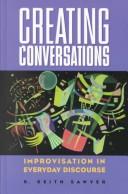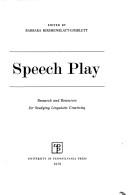| Listing 1 - 10 of 80 | << page >> |
Sort by
|

ISBN: 1572733306 Year: 2001 Publisher: Cresskill (N.J.) : Hampton press,
Abstract | Keywords | Export | Availability | Bookmark
 Loading...
Loading...Choose an application
- Reference Manager
- EndNote
- RefWorks (Direct export to RefWorks)
Book
ISBN: 1793634270 9781793634276 9781793634269 Year: 2020 Publisher: Lanham Lexington Books
Abstract | Keywords | Export | Availability | Bookmark
 Loading...
Loading...Choose an application
- Reference Manager
- EndNote
- RefWorks (Direct export to RefWorks)
In Language Creativity: A Semiotic Perspective, Simone Casini aims to frame the concept of creativity within a linguistic dimension by developing a theoretical reflection with constant references to contact languages and to the educational plan. Semiotic creativity abandons the condition of the linguistic property inter pares and rises to the rank of theoretical and first principle by which languages define themselves, function and interact in the negotiation of meaning in relation to the social uses. Casini considers creativity as a premise for the rule changing of boundaries of meaning and creation of language and meaning. The work progresses starting from the historical-critical concept of creativity, discussing the most philosophical and linguistic theories in the North American and European context.
Creativity (Linguistics) --- Psycholinguistics --- Semiotics
Multi
ISBN: 9781501503993 9781501503962 9781501511844 150151184X 1501503960 Year: 2017 Publisher: Boston, [Massachusetts] ; Berlin, [Germany] : De Gruyter Mouton,
Abstract | Keywords | Export | Availability | Bookmark
 Loading...
Loading...Choose an application
- Reference Manager
- EndNote
- RefWorks (Direct export to RefWorks)
Interest in language play and linguistic creativity has increased in recent years, and the topic has been taken up from a variety of perspectives. In this book, disparate approaches to the topic are brought together, demonstrating that a number of phenomena whose similarities might not have been immediately recognized, have an academic home under the umbrella of language play and linguistic creativity. The contributions to this collection illustrate the variety of questions that can be asked regarding the social, cognitive, emotional, political, and cultural mechanisms and significance of innovative linguistic practices and point to new directions of inquiry. Furthermore, the work exemplifies a variety of ways in which this research can be carried out, as well as the range of contexts in which it might be investigated, including second language classrooms, online settings, and workplaces. Taken together, the chapters serve to illustrate the range of work that we will be accepting in the Language Play and Creativity series; viewed individually, each makes a unique contribution to some aspect of our understanding of creative language use.
Linguistics --- Creativity (Linguistics). --- Plays on words. --- Sociolinguistics. --- Creativity (Linguistics)
Book
Year: 2018 Publisher: Amsterdam ; Philadelphia : John Benjamins Publishing Company,
Abstract | Keywords | Export | Availability | Bookmark
 Loading...
Loading...Choose an application
- Reference Manager
- EndNote
- RefWorks (Direct export to RefWorks)
This volume unveils the many facets of linguistic innovations in non-native English varieties and explores the fine line between learners' erroneous versus creative use of a target language. Originally published as a special issue of International Journal of Learner Corpora Research 2:2 (2016).

ISBN: 0812277066 1512803154 Year: 1976 Publisher: University of Pennsylvania Press
Abstract | Keywords | Export | Availability | Bookmark
 Loading...
Loading...Choose an application
- Reference Manager
- EndNote
- RefWorks (Direct export to RefWorks)
Book
Year: 1966 Publisher: New York: Harper and Row,
Abstract | Keywords | Export | Availability | Bookmark
 Loading...
Loading...Choose an application
- Reference Manager
- EndNote
- RefWorks (Direct export to RefWorks)
Cartesian linguistics --- Creativity (Linguistics) --- Generative grammar
Book
Year: 2016 Publisher: Cambridge, MA : The MIT Press,
Abstract | Keywords | Export | Availability | Bookmark
 Loading...
Loading...Choose an application
- Reference Manager
- EndNote
- RefWorks (Direct export to RefWorks)
Cognition. --- Creativity (Linguistics). --- Language acquisition. --- Psycholinguistics. --- Spracherwerb.
Book
ISBN: 9780819130921 0819130923 Year: 1983 Publisher: Lanham: University press of America,
Abstract | Keywords | Export | Availability | Bookmark
 Loading...
Loading...Choose an application
- Reference Manager
- EndNote
- RefWorks (Direct export to RefWorks)
Cartesian linguistics --- Creativity (Linguistics) --- Generative grammar
Book
ISBN: 9780415699839 Year: 2016 Publisher: London ; New York : Routledge,
Abstract | Keywords | Export | Availability | Bookmark
 Loading...
Loading...Choose an application
- Reference Manager
- EndNote
- RefWorks (Direct export to RefWorks)
Language and Creativity has become established as a pivotal text for courses in English Language, Linguistics and Literacy. Creativity in language has conventionally been regarded as the preserve of institutionalised discourses such as literature and advertising, and individual gifted minds. In this ground-breaking book, bestselling author Ronald Carter explores the idea that creativity, far from being simply a property of exceptional people, is an exceptional property of all people. Drawing on a range of real examples of everyday conversations and speech, from flatmates in a student house and families on holiday to psychotherapy sessions and chat-lines, the book argues that creativity is an all-pervasive feature of everyday language. Using close analysis of naturally occurring language, taken from a unique 5 million word corpus, Language and Creativity reveals that speakers commonly make meanings in a variety of creative ways, in a wide range of social contexts and for a diverse set of reasons. This Routledge Linguistics Classic is here reissued with a new preface from the author, covering a range of key topics from e-language and internet discourse to English language teaching and world Englishes. Language and Creativity continues to build on the previous theories of creativity, offering a radical contribution to linguistic, literary and cultural theory. A must for anyone interested in the creativity of our everyday speech.
Creativity (Linguistics) --- Discourse analysis. --- Semantics --- Sociolinguistics
Book
ISBN: 9780192843067 Year: 2021 Publisher: Oxford Oxford University Press
Abstract | Keywords | Export | Availability | Bookmark
 Loading...
Loading...Choose an application
- Reference Manager
- EndNote
- RefWorks (Direct export to RefWorks)
"All humans, but no other species, have the capacity to create and understand language. It provides structure to our thoughts, allowing us to plan, communicate, and create new ideas, without limit. Yet we have only finite experiences, and our languages have finite stores of words. Where does our linguistic creativity come from? How does the endless scope of language emerge from our limited selves? Drawing on research from neuroscience, psychology, and linguistics, David Adger takes the reader on a journey to the hidden structure behind all we say (or sign) and understand. Along the way you'll meet children who created language out of almost nothing, and find out how new languages emerge using structures found in languages spoken continents away. David Adger will show you how the more than 7000 languages in the world appear to obey the same deep scientific laws, how to invent a language that breaks them, and how our brains go crazy when we try to learn languages that just aren't possible. You'll discover why rats are better than we are at picking up certain language patterns, why apes are far worse at others, and how artificial intelligences, such as those behind Alexa and Siri, understand language in a very un-human way. Language Unlimited explores the many mysteries about our capacity for language and reveals the source of its endless creativity" --
Creativity (Linguistics) --- Language and languages --- Philosophy
| Listing 1 - 10 of 80 | << page >> |
Sort by
|

 Search
Search Feedback
Feedback About UniCat
About UniCat  Help
Help News
News